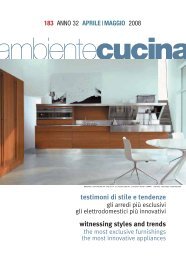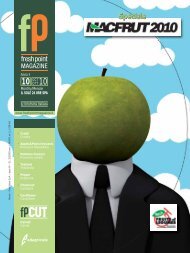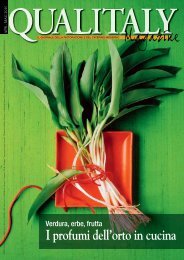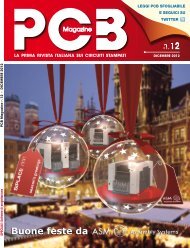Fresh Point Magazine - B2B24 - Il Sole 24 Ore
Fresh Point Magazine - B2B24 - Il Sole 24 Ore
Fresh Point Magazine - B2B24 - Il Sole 24 Ore
You also want an ePaper? Increase the reach of your titles
YUMPU automatically turns print PDFs into web optimized ePapers that Google loves.
innovative solutions. In fact, products can now be<br />
cooled after drying by means of cryogenic (nitrogen)<br />
or hybrid (nitrogen-cold air fl ow) systems.<br />
This represents a Copernican revolution in the<br />
approach to low-temperature management in that<br />
the focus is on cooling the product itself rather than<br />
lowering the room temperature.<br />
The Turatti Company’s Polar Wind tunnel is in fact<br />
a revolutionary solution and innovation that enables<br />
leafy salad greens and fruit to be cooled rapidly<br />
and economically. Given the low temperatures that<br />
it delivers, Polar Wind reduces cooling times and,<br />
hence, notably lowers bacterial count during processing.<br />
It lets you drop the temperature of dried product<br />
from 12-15 °C to 4-5 °C in a rapid 2-3 minutes. This<br />
approach provides staff with a more comfortable<br />
workplace ambience without impairing the maintenance<br />
of the cold chain.<br />
Nitrogen, the best coolant<br />
What’s more, nitrogen cooling has very particular<br />
features that make it preferable to other approaches<br />
to cooling. In effect, it cools in an oxygen-poor<br />
atmosphere that impedes the onset of oxidising phenomena,<br />
thereby considerably improving packaged<br />
product colour and freshness.<br />
che sull’abbattimento della temperatura della sala.<br />
<strong>Il</strong> tunnel Polar Wind della Turatti è infatti una soluzione<br />
rivoluzionaria e innovativa: prodotti quali insalata e frutta<br />
possono essere ora raffreddati in maniera rapida ed<br />
economica. Grazie alle basse temperature ottenibili, i<br />
tempi di raffreddamento vengono ridotti, abbassando<br />
sensibilmente la carica batterica durante il processo di<br />
lavorazione. In questa maniera, si riesce ad abbattere<br />
la temperatura del prodotto asciugato da 12-15 °C a<br />
4-5 °C in tempi molto brevi (circa 2-3 minuti). Questo<br />
permette agli operatori di lavorare in un ambiente più<br />
confortevole, senza tuttavia pregiudicare il mantenimento<br />
della catena del freddo.<br />
Ad azoto, la forma migliore<br />
Per di più, il raffreddamento ad azoto ha caratteristiche<br />
del tutto particolari che lo fanno preferire in molte<br />
applicazioni ad altre forme di raffreddamento. Infatti, il<br />
processo avviene in atmosfera scarsamente ossigenata<br />
impedendo l’insorgere di fenomeni ossidativi sul prodotto,<br />
con considerevoli miglioramenti nel colore e nella<br />
freschezza del prodotto fi nale.<br />
<strong>Il</strong> sistema è essenzialmente costituto da un tunnel criogenico<br />
riprogettato in toto per garantire il raffreddamento<br />
(e non quindi la surgelazione) per varie applicazioni quali<br />
appunto la lavorazione di verdura e frutta fresca di quarta

















